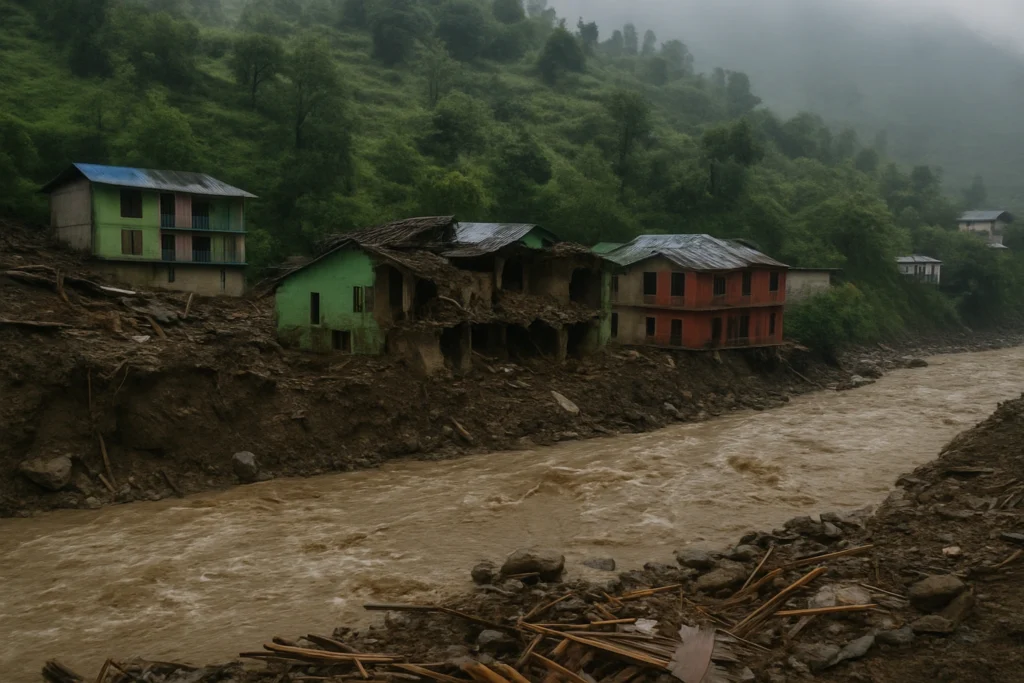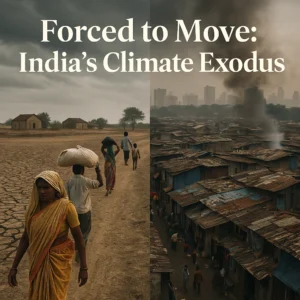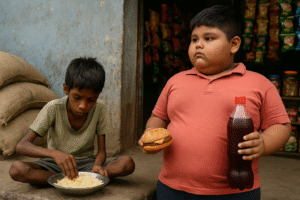Cloudburst in Himachal Pradesh: Over 17 Dead in Kullu and Mandi’s Monsoon Nightmare

The aftermath of a severe cloudburst in Himachal Pradesh, where floodwaters tore through homes in Kullu and Mandi districts, claiming lives and displacing families.
There was no thunder. No time to run. Just a low roar—like a mountain exhaling through its teeth—and then everything turned to water.
This is how Kamla Devi, a 62-year-old resident of Sainj Valley in Kullu, remembers the moment her village was hit by a cloudburst in Himachal Pradesh late last month. “It wasn’t rain. It was punishment,” she says, still clutching a broken bangle that survived the deluge. Her home didn’t. The repeated cloudburst in Himachal Pradesh this monsoon has exposed deep cracks in both infrastructure and policy. What used to be considered isolated weather anomalies have now become almost routine disasters. From Kullu to Mandi, each incident has revealed how unprepared the region remains—despite past warnings and climate studies.
Table of Contents
1. A Month of Monsoon Mayhem
Since June 25, Himachal Pradesh has been battered by multiple cloudbursts. First, Sainj. Then Karsog in Mandi, where nine workers were swept away in a flash flood. Then came Malana, Tikkan, Jaon, and Samej—each reporting sudden downpours, landslides, and villages submerged in minutes.
So far, 17 people are confirmed dead, including two children, with more than 50 missing. These aren’t just numbers—they’re mothers, labourers, apple farmers, taxi drivers. Lives that ended not in stories but in silence.
“I buried my father with my bare hands,” said Suraj Thakur, a 19-year-old from Tikkan, who carried his injured mother downhill and no one came.
Local Panic Grows Amid More Warnings
Panic has gripped many hill towns as the threat of another cloudburst in Himachal Pradesh looms with each rainfall. Locals say they now sleep in shifts, fearing sudden landslides or flash floods during the night. The lack of permanent evacuation plans has only deepened the anxiety in regions like Kullu and Mandi, where cloudburst in Himachal Pradesh incidents have already displaced dozens of families this season.
2. What Makes Cloudbursts in Himachal So Dangerous?
A cloudburst in Himachal Pradesh doesn’t hit like a storm in the plains. It crashes into steep slopes where rivers twist like nerves and homes are often perched like afterthoughts on rock faces. One moment it’s calm; the next, your roof is downstream.
Meteorologists explain the science—warm monsoon winds slam into the Himalayas, rise quickly, and cool down, dropping torrents of water. But residents aren’t looking for definitions.
They’re asking why these disasters are happening more often, and why warnings rarely reach the people who need them.
“We were told there was ‘yellow alert’ on Doordarshan,” says Ramesh Rana, a tea seller in Jaon, “but what does that even mean to someone with no TV or mobile data?”
3. Deforestation, Tunnels, and Tourism Pressure
Experts at SANDRP and the Indian Institute of Ecology have long raised red flags. Himachal’s natural sponge—its forests—have been chipped away for roads, resorts, and dams. Over 120 hydropower projects run through the region, some tunneling through mountains with little oversight.
“We’ve built an ecosystem where water has no way to slow down,” said Dr. Neelam Sharma, an environmental geologist. “When it rains, it doesn’t soak—it surges.”
“Himachal Pradesh monsoon flash flood 2025”, “cloudburst deaths in Kullu and Mandi”, and “hydropower project disaster Himachal” are now part of national news coverage—and part of the blame.
4. Broken Roads, Broken Systems
Several major roads have been cut off, including sections of the Chandigarh–Manali highway. Helicopter rescue teams were grounded for two days due to low visibility. Villagers in isolated areas reported waiting over 36 hours for help.
In Mandi, a temporary school shelter was set up where over 50 families now live, surviving on dal, blankets, and uncertainty. “We can’t go back to our homes,” said Sunita, a mother of three. “There are no homes left.”
Despite IMD alerts and public warnings, there was little local disaster preparedness. No sirens. No drills. No radio bulletins in Pahari dialects.
This isn’t just a climate story—it’s a governance failure.
Also Read “Nowhere to Go”: The Harsh Truth About Climate Migration in India
5. Counting the Cost: Crops, Tourism, and Hope
Tourism in Himachal—worth over ₹8,000 crore annually—is reeling. Bookings in Kullu, Manali, and Kasol have plummeted. Orchard owners say this year’s apple yield is down by 40%. Roads used for crop transport have collapsed into the Beas.
And yet, people aren’t angry. They’re tired.
“Every year we light candles in memory of the lost,” said Prakash Negi, a panchayat head in Mandi. “And every year we rebuild. But now, we don’t know where to start.”
A Pattern That Can No Longer Be Ignored
With over half a dozen cloudburst in Himachal Pradesh events reported within a single month, it’s clear this is no longer an aberration—it’s a pattern. Climate scientists and geologists say Himachal is now facing a new era of monsoon volatility. They warn that ignoring the frequency of cloudburst in Himachal Pradesh will not only cost lives but cripple the state’s economy in the long term.
6. What Needs to Change—Immediately
If the past four weeks are any signal, cloudburst in Himachal Pradesh is no longer a rare phenomenon. It’s the new monsoon reality.
Some urgent changes:
- Community-level early warning systems, even using loudspeakers and manual alerts
- Zoning reforms: no construction near rivers, slopes, or forests without geological clearance
- Mandatory evacuation protocols in red-alert zones
- Permanent disaster relief teams stationed in hill districts, not just deployed after loss
7. Final Word: The Mountains Don’t Lie
Nature doesn’t hold grudges. But it remembers.
What happened in Kullu and Mandi this monsoon wasn’t just a cloudburst. It was years of neglect, unplanned growth, and deafness to the warnings.
The people here don’t need sympathy—they need systems that care before things fall apart. Because if we keep treating the mountains like playgrounds and profit zones, they will keep answering in floods.
And next time, we might not get 17 bodies. We might get hundreds.
You can also go through Himachal Pradesh bears the brunt of monsoon as cloudbursts.






